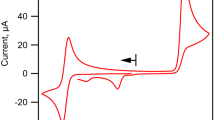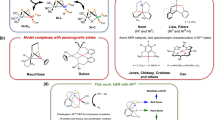Abstract
THE striking shift in the position of the visible absorption bands of dicyano bis (1 : 10 phenanthroline) iron(II) and the corresponding 2-2′-dipyridyl complex caused by the addition of acid was first noted by Schilt1, who has since shown that these compounds react reversibly to give mono- and di-protonated ions2. Schilt suggested that the hydrogen is attached directly to the metal in the protonated species. A second possibility is that the protonated compounds are ‘isocyanides’.
This is a preview of subscription content, access via your institution
Access options
Subscribe to this journal
Receive 51 print issues and online access
$199.00 per year
only $3.90 per issue
Buy this article
- Purchase on Springer Link
- Instant access to full article PDF
Prices may be subject to local taxes which are calculated during checkout
Similar content being viewed by others
References
Schilt, A. A., J. Amer. Chem. Soc., 82, 3000 (1960).
Schilt, A. A., J. Amer. Chem. Soc., 82, 5779 (1960).
Author information
Authors and Affiliations
Rights and permissions
About this article
Cite this article
HAMER, N., ORGEL, L. Structure and Spectra of [(Phenanthroline)2Fe(CNMe)2]2+ and [(Phenanthroline)2Fe(CN)2H2]2+ . Nature 190, 439–440 (1961). https://doi.org/10.1038/190439a0
Issue Date:
DOI: https://doi.org/10.1038/190439a0
This article is cited by
-
Kinetics and mechanism of the ligand substitution reaction between aquapentacyanoruthenate(II) and 4-cyanopyridine in the presence of anionic surfactant micelles
Transition Metal Chemistry (2010)
-
Solvatochromic behaviour of intramolecular charge-transfer spectra of inorganic diimine complexes
Transition Metal Chemistry (1981)
-
Electrophilic substitution in phenanthroline coordinated to transition metal ions. Rates of nitration of some rhodium(III) and cobalt(III) complexes
Transition Metal Chemistry (1976)
Comments
By submitting a comment you agree to abide by our Terms and Community Guidelines. If you find something abusive or that does not comply with our terms or guidelines please flag it as inappropriate.



